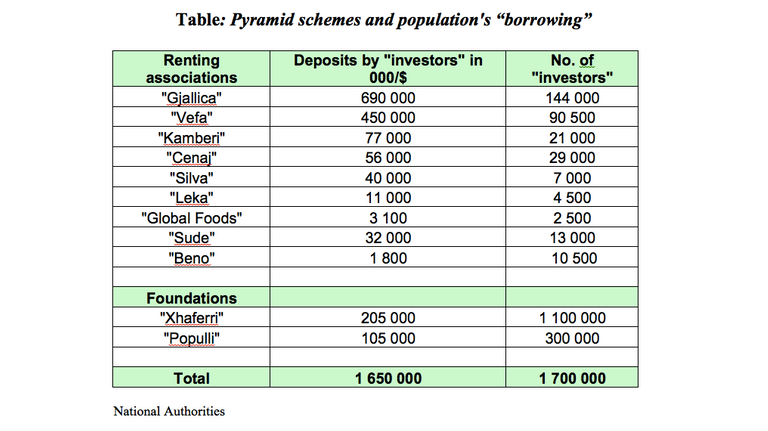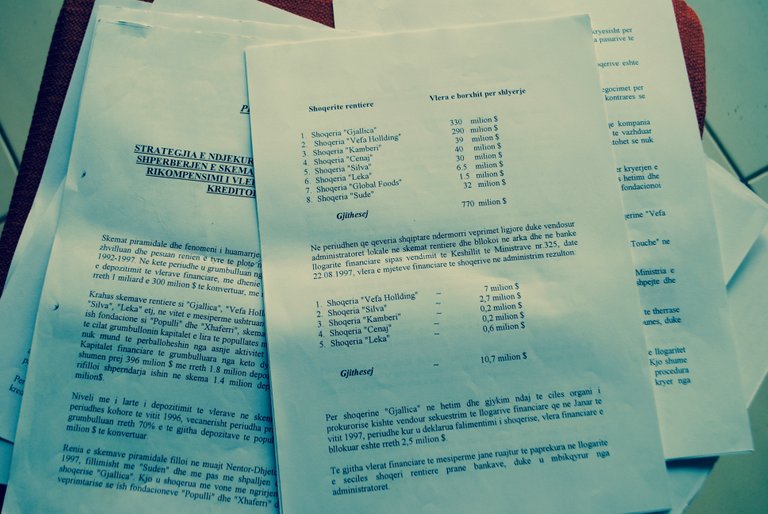It was Spring 1997. I was 9 years old. I remember I was in the center of Korca city (my hometown) with my father and suddenly, we started to hear screams and shouts. When we arrived in front of prefecture’s building, we saw groups of people throwing stones at it. It was the beginning of a civil war that took more than 3000 lives in less than 1 year and it reached a dangerous point that my country needed military intervention from United Nations.

It is well-known the fact that main cause of social transition that occurred in 1997, is the fall of Pyramid schemes. Many Albanians invested huge amounts of money into these dishonest companies, two of which were charity organizations such as “Populli” and “Xhaferri”. The fall of Pyramid schemes led to the violent anarchism which also caught the attention of International arena. I was a little kid when it happened, and to say the truth, I don't remember too much. I remember a lot of gun shots and bombs and we were sleeping with windows covered with mattresses to avoid the “blind” bullets.
It is of great importance to state that Albania , as a country which suffered from communism regime for a long time, after 1992 faced many difficulties in financial and banking system due to a transitional transformation of political regime. The conversion of this country, from a totalitarian regime to democracy, is still under transition.
Oh, by the way, there are two types of fraud. The fraudulent Albanian organizations were a combination of both, Pyramid and Ponzi schemes.
How It Began
The emergence of pyramids scheme resulted from the problems in the financial sector and the existence of informal credit market. Three public banks were slowly working to attract domestic savings. They set low-interest rates, therefore, citizens were not so interested in deposits their money in the banks. Most of the Albanians were keeping high amounts of money in cash, hidden in their houses.
Regarding the issue of the informal credit market, national authorities didn’t pay attention to audit this sort of trade. Basically, it consisted of unlicensed foreign exchange dealers. They were illegal. Nevertheless, these illegal companies were the bridge between immigrants and their resident families. We have to bear in mind that after the openness of border in 1990, a great number of Albanians moved abroad for economic reasons. These immigrants were the main financial source for a lot of jobless Albanians. The correct term to use is remittances.
Another profound factor is the negligence of the government. The law against the pyramid schemes came into reality in February 1996, which stipulated that “no person other than a bank shall accept household deposits, demand deposits, and deposits with an initial maturity of 12 months or less” (Law No. 8075, dated 2/22/96, Article 6). Even after this passed law, there were no audits undertaken by national authorities. It is clear that behind the Pyramids, there were also politicians that supported the Pyramids because they were benefiting from them. There is no clear and sound evidence that states the direct implication of politicians.
According to national authorities, Pyramid schemes were born and developed from 1992-1997. Among rental scheme, there also were foundations such as “Populli” and “Xhaferri”. Those two last organizations were obviously fraudulent corporation.

Referring to the table, we can observe that “Gjallica”, “Xhaferri”, “Vefa” had the highest number of “investors”. There is no wonder that social turmoil took place after the collapse of deceptive schemes. At that time, the overall population of Albania was approximately 3 659 616 ( these estimates are taken from “CIA-The World Fact I strongly believe we were less). In these dishonest companies, there were involved 1 700 000 people, nearly 46 % of the population. Basically, renting associations began their operations as illegal foreign exchange dealers in early 1992. Then, in 1996 they became so popular that they could collect around 70 % of the overall deposits, estimated by the national authorities. The most problematic city was Vlora (The video is graphic, watch at your own responsibility) whose financial loss is calculated up to 50 % for citizens.
As a new democratic country, Albania had always the attention of international organizations such as the World Bank and International Monetary Fund . Both institutions urged Albanian government to take measurements in order to regulate the economic situation. And, one of them was to illegalize the pyramid scheme. When the new government was formed in 1997, a new law passed which abandoned the borrowing money from the public sector. (Law no. 8188, date 23.01.1997)
On an interview with the investigators of Pyramids scheme, one of them (the person wanted to remain anonymous) said that “Pyramid schemes are dishonest and illegal organizations. They can actually pay the return rate in the beginning; however, on later payment, they won’t be able to. Therefore, they are determined to fail.” And this is what happened, “Suda” company declared its bankruptcy on November 1996. Other companies collapsed after three and four months or January-February.

Why Citizens Went To This Companies?
Considered as a poor country, especially after 1990, Albanian were, in fact, able to invest in the pyramid scheme. The main reasons why they turned to these organization are mistrust to banks and unemployment.
As it is mentioned above, the Albanian financial market wasn't progressing enough. People weren't attracted to their low-interest rate, leading citizens to go to illegal foreign exchange dealers who would promise 50 % of investment return. Essentially, these deceptive companies found a proper environment to develop due to their insufficient knowledge of pyramid scheme.
Then, the unemployment and greed of people to win money easily let the country to disastrous conditions. They had negative impacts on political and social spheres as well as economic; although the financial sector achieved to recover in a short period due to foreign expertises by international organizations such as IFM and the World Bank. An unstable economy and a dysfunctional government proved to be good factors for the emergence of Pyramid scheme in Albania.
The special department that investigates pyramid schemes is still working to follow the money transactions that occurred in the period of 1992-1997 in order to compensate to people the money they lost.

To end up, it would be more appealing if there were a real research and investigation of financial statements of these fraudulent organizations in order to understand in depth how they really function. However, keep in mind: after the collapse of Pyramids financial statements and sheets were completely destroyed or burned by the owners. And another important issue is that Albanians have always and still blame the government for the Pyramids scheme. Whether it is true or not, we will never know. Valid and clear evidences do not exist anymore.
The case of Albanian pyramid scheme is a lesson to other countries and it’s still an open wound to many people, majority of them never got their money back. Nowadays, it’s still a big question: Where did all this money go?
I am aware of some Wikileaks documents related to this period, but I was not able to find them.
Note: Majority of my conclusions are based on a lot of readings if you would like to know more about Albanian Ponzi Scheme:
Bezemer, Dirk J.. “Post-socialist Financial Fragility: the case of Albania”. Tinbergen Institute and University of Amsterdam
Elbirt, Carlos. (2001). “Albania under the Shadow of Pyramid Scheme”.The World Bank Group
De Coulon, Augustin; Piracha, Matloob. (2003).“Self-Selection and the Performance of Return Migrants: the Source Country Perspective”. JEL classification
Jarvis, Chris. (2000). “The rise and fall of Pyramid Scheme in Albania”.IMF staff papers.
Korovilas, James.(1999) “The Albanian economy in transition: the role of remittances and pyramid investment scheme”.Post-communist economies.
Svejnar, Jan.(2002). “Transition economies: Performances and challenges”.The Journal of Economic Perspectives
Rother, Philiph C..(2000). “Inflation in Albania”. IMF working paper.
(1997)“Albanian Clash in Pyramids-Scheme protest”. The New York Times
Valentine, Debra. (1998). “Pyramid Schemes”. International Monetary Fund's Seminar on current legal issues affecting central banks.
Wells, Joseph. (2000).“That's why it is called a Pyramid Scheme”. Journal of Accountancy.
It's pretty amazing to see how financial institutions are involved in conflicts and the fact that their leaders are never prosecuted and continues to live with impunity. Not only in Albania, not only at war time.
Very good post. Thanks for sharing.
the irony is the founders of these pyramid schemes went to prison. After they got out of jail, they are suing government to return the money of their "companies" LMAO
ponzi schemes are the worst
yes. we got hit very very hard.
Interesting article. There is no good in usury. There are no honest get-rich-quick schemes.
great history, very good development of the theme congratulations
i wish it never happened :)
Very interesting. I only remember a little bit of what happened. It is also fascinating that Albania is small and different than its surrounding countries. I have wondered in the past what it's like living there.
everybody is leaving. You get the idea? :)
A whole country, falling for ponzies... Amazing.
I do expect them to not fall into the ones we see everyday on Internet as cryptoenthusiasts after that lesson.
it's not amazing. did you read the post why they fell for it?
Whoah!
i know.
Ah yes, 1997....I remember that year, I was a bit older than you, I was 16 :)
I remember the bullets flying every which way. My family and I went to Greece for a few months in March to escape the chaos (and bullets) and I had to quit school during that time, I was a sophomore in high school. Those were pretty difficult times!
But look at us now, steeming about it :)
i know it's hard to believe.